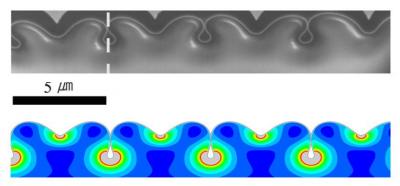
Wrinkles, which are forerunners of normal folds, are formed when a thin film is clasped on a soft base, and further compression of the sheet will result in the formation of folds due to the tight spacing of wrinkles. Manufacturers show interest on these folds, as they can accommodate large surface area in a limited space.
The researchers placed 20-80 nm thick sheets of gold nanogranular film on a rubbery substrate that is widely utilized in the microelectronics industry. They then compressed the sheet to form wrinkles and studied their properties. In earlier investigations, they observed primary wrinkles having short periodicities, which represent the distance between valleys or peaks of individual wrinkles. Now, they have found another type of wrinkle having a periodicity longer than that of the primary wrinkles, resembling a hidden long wave.


No comments:
Post a Comment